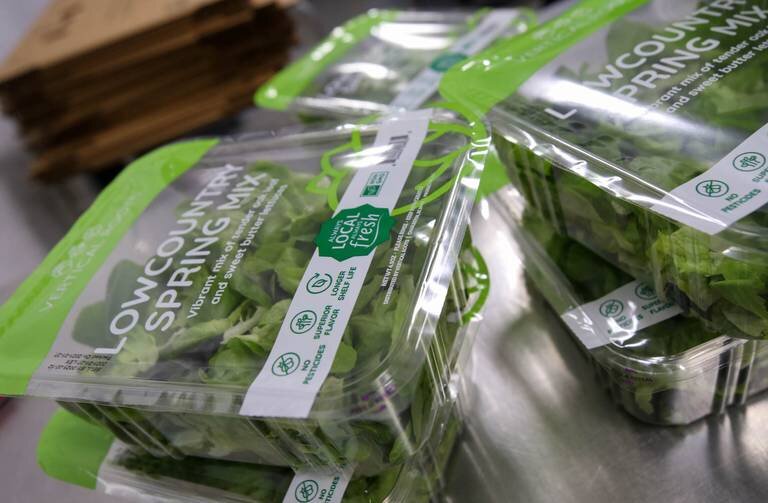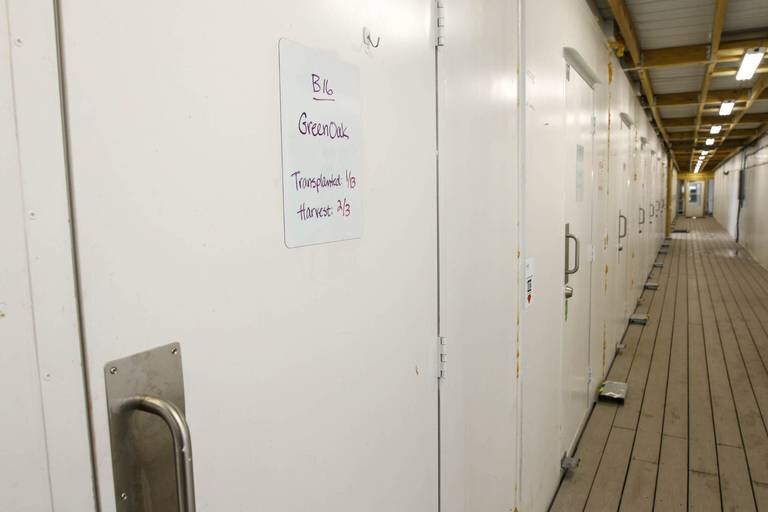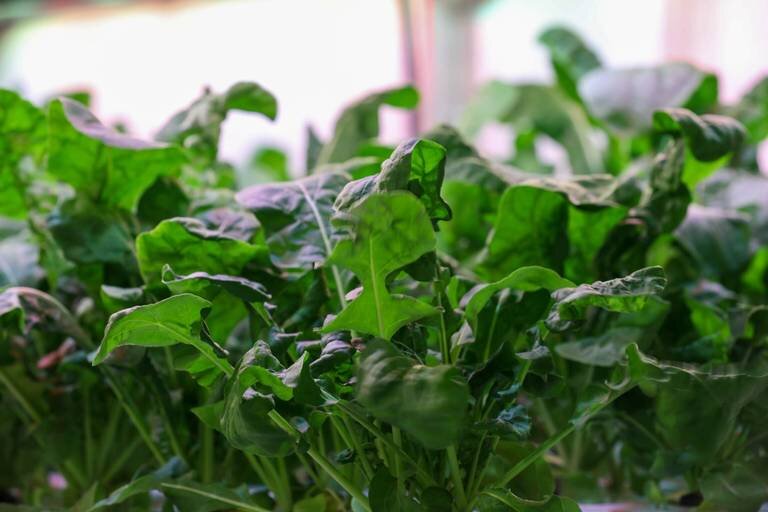
Welcome to iGrow News, Your Source for the World of Indoor Vertical Farming
Columbia Vertical Farm Uses Technology To Cut Plastic Pollution And Boost Sustainability
The new packaging comes at no extra cost to the customer and will be cheaper in the long-run for Vertical Roots
Vertical Roots is the largest hydroponic container farm in the country. They grow and package lettuce varieties and have recently implemented a packaging process that reduces plastic with a resealable film. TRACY GLANTZ TGLANTZ@THESTATE.COM
With the use of agricultural technology, Vertical Roots farm in West Columbia created a packaging system for its leafy greens that cut down the company’s plastic usage by 30% and extends the shelf life of the lettuce.
In 2015, high school friends Andrew Hare and Matt Daniels created the idea for Vertical Roots, now the largest hydroponic container farm in the country. Hare is the general manager of the company and Daniels acts as the chief horticulturist.
The first Vertical Roots opened in Charleston and expanded with its second farm site in West Columbia in 2019. Vertical Roots parent company, AmplifiedAg, manufactures the container farms and farm technology of which Vertical Roots operates.
The farms are part of a growing industry called controlled environmental agriculture (CEA) that uses technology to ramp up nutrient-rich food production year around.
Hydroponics helps the farm uses 98% less water than traditional farming, according to Hare. Their technology creates an indoor environment to grow lettuce on the East Coast. Most lettuce in the U.S. comes from California and Arizona, where temperatures do not fluctuate much throughout the year, travelling 2,000 miles from farm to table. Vertical Roots offers a solution for local lettuce.
“Our mission is to revolutionize the way communities grow, distribute and consume food,” said Hare. As populations grow, Hare said the ability to produce enough food is a global concern.
VERTICAL ROOTS AGRICULTURAL INNOVATION
As a company committed to sustainability, Vertical Roots had to address its plastic usage and the consumer demand for environmentally friendly products.
“I think everyone can agree that the amount of plastic that’s consumed and used globally is a bit of a problem,” said Hare.
If Vertical Roots were to completely opt-out of using plastics, as much as 40% of the lettuce would be damaged in transportation to the retailers, Hare said. So the company decided to still use plastic containers in order to cut out food waste, but it changed the amount and type of plastic used.
By replacing the conventional “clamshell” plastic lids that you see on a container of lettuce at the grocery store, Vertical Roots cut down more than 30% of plastic usage by creating a resealable film lid. The new packaging comes at no extra cost to the customer and will be cheaper in the long-run for Vertical Roots, according to Hare.
The farm also uses recycled plastic that can also be recycled again after use. Tiny perforations in the film lid of the packaging allow air to leave the lettuce container and extends the product’s freshness, making Vertical Roots lettuce last around 14 days on the shelf.
“We tested respiration and condensation with each lettuce variety, and ultimately found that we could extend the freshness and shelf life of our salad mixes even more,” said Hare.
Vertical Roots, at the S.C. Farmer’s Market, is the largest hydroponic container farm in the country. They grow and package lettuce varieties. Tracy Glantz TGLANTZ@THESTATE.COM
GROWTH IN THE AGRICULTURAL TECHNOLOGY INDUSTRY
In the first three quarters of 2020, a record $754 million of venture capital was invested in the vertical farming industry, according to PitchBook data. This was a 34% increase from the entire previous year, Bloomberg reported in a January article.
A 2019 report from Global Market Insights showed that the vertical farming market size, or the number of potential customers or unit sales, surpassed $3 billion in 2018 and said it, “will exhibit a massive compound annual growth rate (CAGR) of over 27% from 2019 to 2026.”
In vertical farms, crops are harvested on several vertical layers indoors, where farmers can grow year-round by controlling light, temperature, water and other factors, according to the U.S. Department of Agriculture.
Vertical agriculture is also seen as a growing industry because it “could help increase food production and expand agricultural operations as the world’s population is projected to exceed 9 billion by 2050,” according to the USDA.
However, some are skeptical about the future of vertical farming for several reasons. The farms use LED light bulbs to grow crops, which require a lot of energy and money to operate.
Also, the farms mostly produce greens, which are low in calories because they take less water and light. The new farming technology is marketed as a way to combat world hunger, but in poorer countries, low-calorie greens are not as beneficial, according to Bloomberg.
THE FUTURE OF VERTICAL ROOTS
Despite a tough year due to COVID-19, Vertical Roots will open two more indoor, container farms in Georgia and Florida in 2021.
The company lost revenue from foodservice customers like restaurants, schools and universities during the pandemic, said Hare.
Those food service customers accounted for about half of Vertical Roots’ business, Hare said. Grocery store business stayed steady and even grew during the pandemic. As schools and restaurants are slowly reopening, Vertical Roots is gaining business back.
The West Columbia farm location produces about $1.5 million pounds of produce per year, said Hare. Vertical Roots lettuce is in 1,200 different grocery stores in 11 states, including Lowes Foods stores, Publix, Harris Teeter and Whole Foods Market chains.
Hare said the company is constantly working on sustainable initiatives, including figuring out a way to reduce light energy consumption by 20-25%, thinking about compostable packaging systems and finding ways to use less water at the farms.
In the future, Vertical Roots hopes to offer a larger variety of produce. The team is experimenting with growing foods like tomatoes, cucumbers, peppers, herbs and mushrooms to see if they could be viable products.
At 25,000 square feet, the world's first indoor vertical farm is also one of the largest farms. Located 120 miles south of Seoul, South Korea, fruits and vegetables grow without soil, bathed in light from pink LEDs. BY META VIERS
1 of 3
Vertical Roots, at the S.C. Farmer’s Market, is the largest hydroponic container farm in the country. They grow and package lettuce varieties. TRACY GLANTZ TGLANTZ@THESTATE.COM
Lawsuit Over Keurig Coffee Pod Recyclability Moves Forward
A federal judge in California recently ruled that a class action lawsuit against Keurig Green Mountain Inc. — one with interesting implications for recyclability claims about new product streams — can move forward
The Company Had Hoped A California Judge Would Dismiss A
Complaint Claiming its "Recyclable" Labels Are Misleading
AUTHOR Katie Pyzyk@_PyintheSky
July 15, 2019
A federal judge in California recently ruled that a class action lawsuit against Keurig Green Mountain Inc. — one with interesting implications for recyclability claims about new product streams — can move forward.
The lawsuit was proposed by a California consumer who says the company (now Keurig Dr Pepper) made false claims about its coffee pods' recyclability, namely that their size, composition and lack of an end market renders them unrecyclable. The suit points out that while the pods are made of polypropylene — a plastic (#5) accepted for recycling in about 61% of communities nationwide — most domestic MRFs aren't capable of capturing such small, light materials from the recycling stream.
According to the lawsuit, Keurig adds to the problem by telling consumers they need not remove the pods' paper filters before recycling. This creates a source of contamination, as it does for numerous other products made from multiple materials that are recyclable only when segregated, including paper envelopes lined with bubble wrap and aluminum cans with plastic shrink wrap sleeves.
Keurig had hoped the lawsuit would be dismissed on the grounds that advertising and labels for the coffee pods encourage consumers to "check locally" about whether the pods are recyclable. It claimed consumers would understand the items aren't recyclable in all markets, despite being labeled as recyclable. The judge, however, found this defense to be lacking because consumers allege the pods aren't recyclable through any MRF in the country, so telling them to "check locally" doesn't make Keurig's recyclability claims true.
"[C]ommon sense would not so clearly lead a person to believe that a package labeled 'recyclable' is not recyclable anywhere," U.S. District Judge Haywood Gilliam wrote in the ruling. "[A]lthough Keurig argues that its labeling is sufficient under the Green Guides... the complaint alleges facts that indicate the opposite."
The Green Guides are the Federal Trade Commission's advice on the types of marketing claims manufacturers can make about their products' recyclability. The goal is to prevent manufacturers from making deceptive or overtly false claims. A key part of the Green Guides is a section commonly referred to as the "60% access rule" – companies can make unqualified claims about a product's recyclability only when a substantial majority (60%) of customers or communities where the item is sold have access to recycling facilities accepting the material. In other words, while a product may technically be recyclable, it won't necessarily be considered as such in regions without adequate processing or sorting infrastructure.
Concerns over coffee pods' contribution to the waste stream have circulated for years following the product's growing mainstream popularity. Even the pods' inventor weighed in on the issue in 2015, saying he regretted inventing them due to their lack of recyclability.
But in the years since, manufacturers have made concerted efforts to create products that can be diverted from disposal. For example, Nespresso periodically expands its coffee pod mail-back recycling program. It partnered with Sims Municipal Recycling and New York's Department of Sanitation earlier this year to devise better strategies for recovering single-serve pods from the curbside recycling stream.
Two years ago, Keurig Green Mountain announced all of its Canada-made coffee pods would be recyclable by the end of 2018. The company released updated sustainability goals last month, including using 100% recyclable or compostable packaging and sending no waste to landfills by 2025. It also reiterated its previous goal of making all coffee pods recyclable by 2020.
Keurig Green Mountain was among the Association of Plastic Recyclers' (APR) initial group of Recycling Demand Champions, a campaign to expand market demand for recycled resins and improve plastic recycling in North America. According to APR, the two entities have "worked extensively" with one another to transition to a recyclable coffee pod container, and Keurig faced the same technological challenges as other companies that manufacture small, light, difficult-to-sort containers.
"Their efforts have led to the creation of technology and protocols that will be used by all brand owners that will allow more containers to be captured from the waste stream, thereby increasing the amount of material available for recycling while reducing contamination," APR President and CEO Steve Alexander told Waste Dive in a statement. "There have been few, if any, companies who have undertaken the vast array of efforts that Keurig has to address the sustainability of their products."
Keurig did not respond to a request for comment about the lawsuit prior to this story's publication.
In 2017, a company representative spoke at an event hosted by the Institute of Scrap Recycling Industries (ISRI) MRF Council about the company's strategy to make the pods recyclable by 2020. Some of ISRI's core work centers on creating products with end-of-life recycling principles in mind, and through its Design for Recycling program presents an annual award to a company that embodies these principles.
A Keurig representative also spoke about coffee pod MRF tests during a session at WasteExpo 2017. The company tracked the pods at facilities using RFID chips and determined 90% of them made it through the container line. That study prompted the Sustainable Packaging Coalition to name Keurig Green Mountain a 2017 Innovator Award Winner for Breakthrough Process, citing factors such as full traceability, non-disruptive testing and in-depth data capture.
The class action lawsuit underscores the difficulty manufacturers face with making accurate recyclability claims. Recycling is a regional practice, and materials that are accepted in one market can be rejected in others. While efforts to standardize national messaging are gaining traction, an increasingly complex material stream will continue to present recycling challenges.
Follow Katie Pyzyk on Twitter
Filed Under: Corporate Marketing Sustainability








